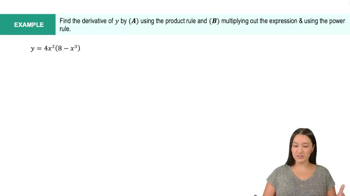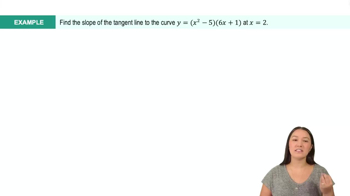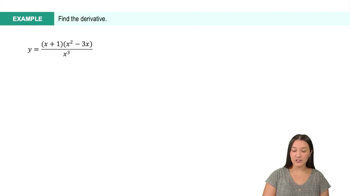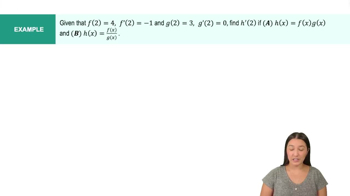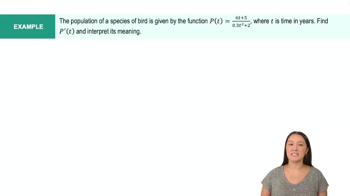Table of contents
- 0. Functions7h 52m
- Introduction to Functions16m
- Piecewise Functions10m
- Properties of Functions9m
- Common Functions1h 8m
- Transformations5m
- Combining Functions27m
- Exponent rules32m
- Exponential Functions28m
- Logarithmic Functions24m
- Properties of Logarithms34m
- Exponential & Logarithmic Equations35m
- Introduction to Trigonometric Functions38m
- Graphs of Trigonometric Functions44m
- Trigonometric Identities47m
- Inverse Trigonometric Functions48m
- 1. Limits and Continuity2h 2m
- 2. Intro to Derivatives1h 33m
- 3. Techniques of Differentiation3h 18m
- 4. Applications of Derivatives2h 38m
- 5. Graphical Applications of Derivatives6h 2m
- 6. Derivatives of Inverse, Exponential, & Logarithmic Functions2h 37m
- 7. Antiderivatives & Indefinite Integrals1h 26m
- 8. Definite Integrals4h 44m
- 9. Graphical Applications of Integrals2h 27m
- 10. Physics Applications of Integrals 2h 22m
3. Techniques of Differentiation
Product and Quotient Rules
Problem 3.4.12a
Textbook Question
7–14. Find the derivative the following ways:
a. Using the Product Rule (Exercises 7–10) or the Quotient Rule (Exercises 11–14). Simplify your result.
g(s) = 4s³ - 8s² +4s / 4s
 Verified step by step guidance
Verified step by step guidance1
Step 1: Identify the function g(s) = \frac{4s^3 - 8s^2 + 4s}{4s}. This is a rational function, so we will use the Quotient Rule to find its derivative.
Step 2: Recall the Quotient Rule, which states that if you have a function h(s) = \frac{u(s)}{v(s)}, then the derivative h'(s) is given by \frac{u'(s)v(s) - u(s)v'(s)}{(v(s))^2}.
Step 3: Assign u(s) = 4s^3 - 8s^2 + 4s and v(s) = 4s. Calculate the derivatives: u'(s) = \frac{d}{ds}(4s^3 - 8s^2 + 4s) and v'(s) = \frac{d}{ds}(4s).
Step 4: Compute u'(s) = 12s^2 - 16s + 4 and v'(s) = 4. Substitute these into the Quotient Rule formula: g'(s) = \frac{(12s^2 - 16s + 4)(4s) - (4s^3 - 8s^2 + 4s)(4)}{(4s)^2}.
Step 5: Simplify the expression for g'(s) by expanding the terms in the numerator and then combining like terms. Finally, simplify the entire expression by dividing each term by (4s)^2.
 Verified video answer for a similar problem:
Verified video answer for a similar problem:This video solution was recommended by our tutors as helpful for the problem above
Video duration:
6mPlay a video:
Was this helpful?
Key Concepts
Here are the essential concepts you must grasp in order to answer the question correctly.
Product Rule
The Product Rule is a formula used to find the derivative of the product of two functions. If u(s) and v(s) are two differentiable functions, the derivative of their product is given by u'v + uv'. This rule is essential when dealing with functions that are multiplied together, allowing for the correct application of differentiation.
Recommended video:
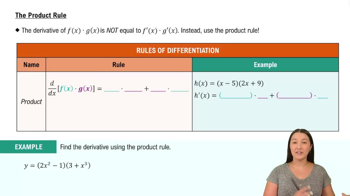
The Product Rule
Quotient Rule
The Quotient Rule is used to differentiate a function that is the quotient of two other functions. If u(s) and v(s) are differentiable functions, the derivative of their quotient is given by (u'v - uv') / v². This rule is particularly important when the function is expressed as a fraction, ensuring accurate differentiation while considering the relationship between the numerator and denominator.
Recommended video:
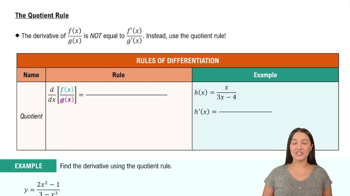
The Quotient Rule
Simplification of Derivatives
After applying the Product or Quotient Rule, it is often necessary to simplify the resulting expression. This involves combining like terms, factoring, or reducing fractions to make the derivative easier to interpret and use. Simplification is a crucial step in calculus, as it helps clarify the behavior of the function and its rate of change.
Recommended video:

Derivatives
Related Videos
Related Practice



